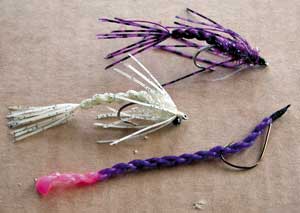
Snow geese are hard enough to hunt in November. By this time of year, the birds have seen and heard it all.
When it comes to fly fishing for bass and panfish, the late Tom Nixon of Lake Charles was not just considered one of the greats, he’s wrote the book on the subject. Although it’s been out of print for many years, “Fly Fishing and Fly Tying For Bass and Panfish” is as relevant today as it was when it first came to print three decades ago. Some things never change, especially the principle that guided Nixon to create his most productive patterns.
“When things get tough,” Nixon once told an audience, “try and match the baitcaster’s hatch.”
Matching the hatch is a term often used in trout circles, to infer that the best means to catch trout is to use a fly that most resembles the insects hatching on the stream at the time.
The warmwater equivalent is to match whatever the baitcasters are having the most success with. For example, if a topwater plug is working, fish a popper. If a spinnerbait is working, fish a fly that utilizes a spinner.
Just about any lure can be mimiced by a fly. However, there is one lure that until a few years back, simply had no equivalent in the fly box.
When the Creme Lure Company of Tyler, Texas, produced the first plastic worms in the early 1950s, it revolutionized the sport of bass fishing. Trying to find a bass angler’s tackle box that doesn’t have plastic worms is like trying to find a Nick Saban fan in Miami.
Nothing, absolutely nothing, is as effective, or as much fun, as catching bass on worms.
The fly rodder’s answer to this was to imitate the worm using fur and feathers. At one time, just about every fly shop carried a variety of “hare worms,” named such because they consisted of a dyed rabbit strip tied to a weighted hook.
Early on, I discovered two problems with hare worms. First, they were bulky and air-resistant, and needed a 9-weight or 10-weight just to keep from plowing into the back of my head during casting.
Second, they simply didn’t catch fish. Even on days when a bare hook worked, the bass in my pond simply had no use for a hare worm.
Enter Ted Cabali of River Ridge.
When I first met Cabali 15 years ago, he was already playing around with silli-legs and making various flies out of this synthetic material. One day he gave me a couple of new creations, and said to try them for bass. So I did.
Wow. Those first few weeks of fishing the Sqwirm Worm in the pond had me leaping out my pants. Not only did they tear up the largemouths, but I was casting, hooking and battling these fish using my light 5-weight rod.
Thanks to Cabali’s ingenuity, the same stuff that bass anglers use for spinnerbait skirts makes one of the deadliest worm imitations. There are several variations, but the simpliest one works just great. Here’s how to tie it.
Materials
Sillilegs, a.k.a. Silli Legs, Silicon Skirts, come in many colors, patterns and sizes, and can be found at all fly shops and many Toledo Tackle stores in Louisiana.
This fly calls for using the regular-size cut silicone skirt layers that are slit to the last 1/4 inch on each end. The layers are very easy to use because the ends are not slit. Other materials will include a bass-sized hook like the Mustad 37187 size 1 and black flat waxed thread.
Instructions
Each layer of sillilegs contains 20-22 strands. Depending on how thick a worm you wish to make, 10 to 16 strands are needed. The thinner worms are more limp, have more action in the water and are easier to cast with a light rod. This needs to be balanced by the fact that thicker worms can catch the bigger bass.
Let’s make a 12-strand worm. Seperate each layer into two sets of strands, six each. Cut one end of the layer, but leave the other end intact. Grab the cut ends, seperate them, and begin twisting. After enough twists, poke a finger in the middle (where the layer end is), bring one end back to the other, and let the two ends slowly twist on each other.
If the worm comes up a bit crooked, pull and stretch the worm out a few times, and this will straighten it up. Use small paper clips to hold the worms in place until the tying process is ready.
Bend the top 1/4 inch of the hook backward about 15 degrees. Then tie in one end of your sqwirm body onto this bent section. The worm will fall right alongside the point. In fact, pass the hook between Sqwirm strands. Attaching a mono weedguard at this point also acts to keep the sqwirm from sliding off the hook point and doing crazy things.
At the tail end, add a few drops of epoxy so that the twists hold up even after several bass have eaten this fly. The epoxy also adds a touch of bouyancy to the tail.


